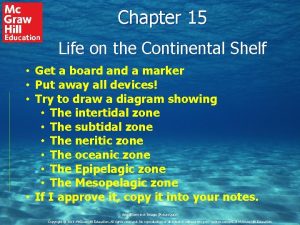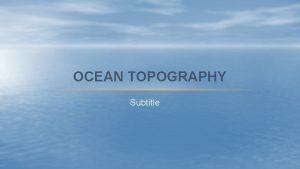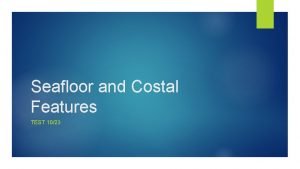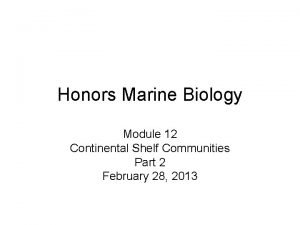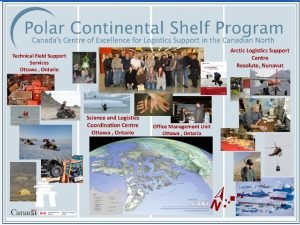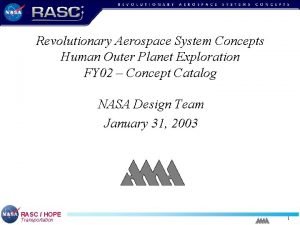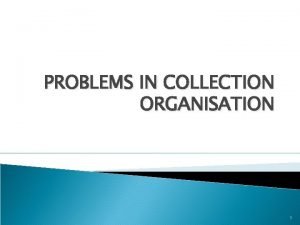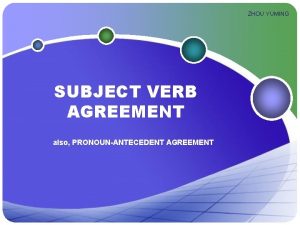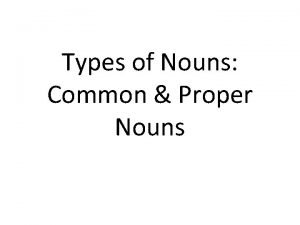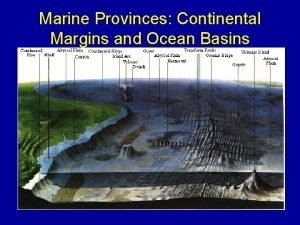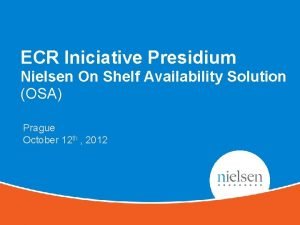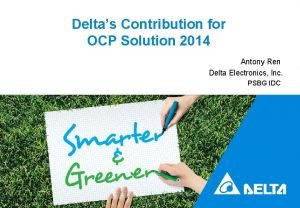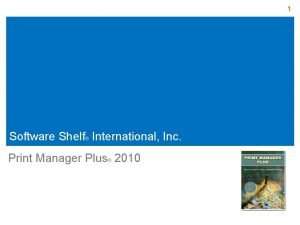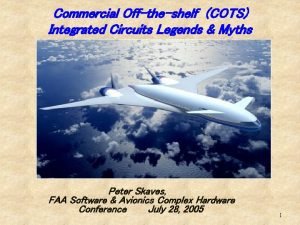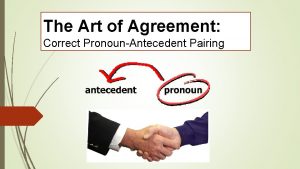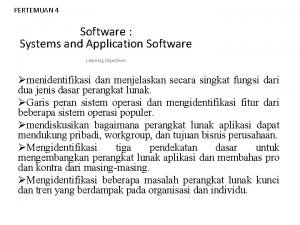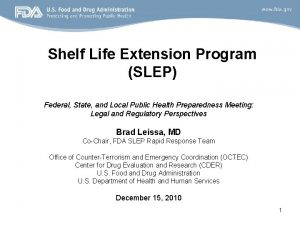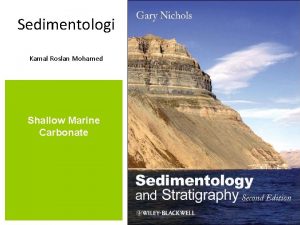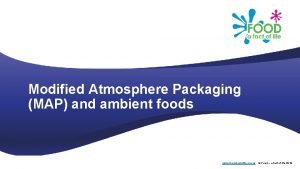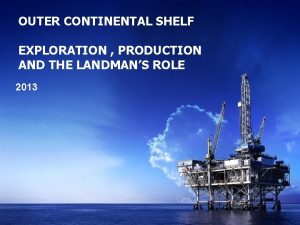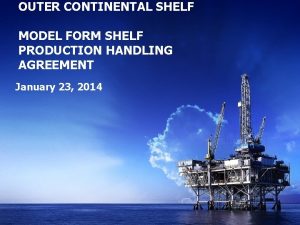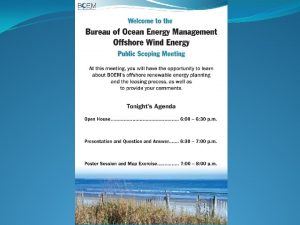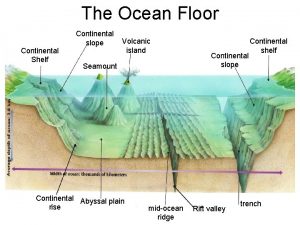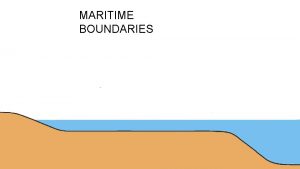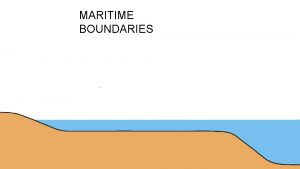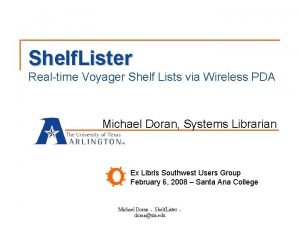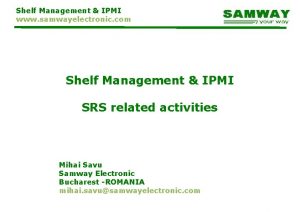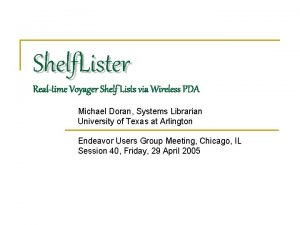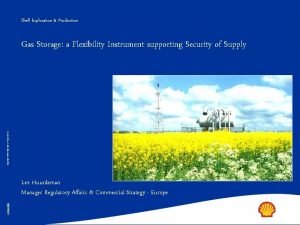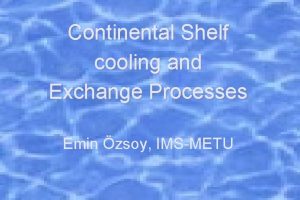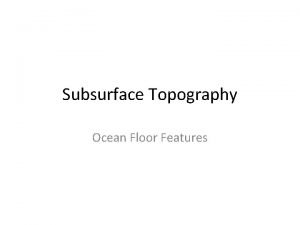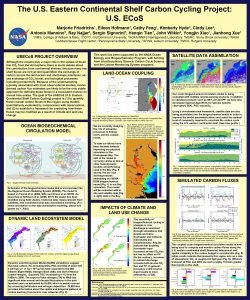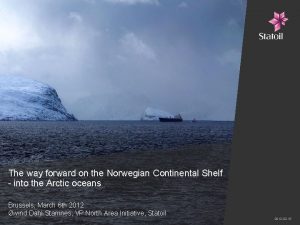OUTER CONTINENTAL SHELF EXPLORATION PRODUCTION AND THE LANDMANS



















































































- Slides: 83

OUTER CONTINENTAL SHELF EXPLORATION , PRODUCTION AND THE LANDMAN’S ROLE 2013

TABLE OF CONTENTS I. III. IV. V. VIII. Disclaimer What is the Outer Continental Shelf (OSC)? Why Invest in the OCS? Exploration on the OCS Production Operations on the OCS Regulation and The U. S. Government The Role of the Landman Fruit of the Labor

I. DISCLAIMER The views expressed in this presentation reflect those of various members of the OCS Advisory Board (“OCSAB”). They should not be considered the views of any particular member of the OCSAB , the company for which a member is employed or such company’s subsidiaries or affiliates (“Companies”). This presentation is being made available with the understanding that neither the OCSAB nor the Companies are rendering legal, accounting or other professional services or advice. This presentation is made available merely as a courtesy and an educational aid. In no event does any member of the OCSAB, the OCSAB or the Companies warrant the accuracy of the information contained herein.

II. What is the Outer Continental Shelf?

Submerged Lands Act of 1953 In 1953, Congress passed the Submerged Lands Act of 1953 which granted ownership to the coastal states of all natural resources lying within three miles of their coast (three marine leagues for Texas and the gulf coast side of Florida, which equal approximately nine miles).

Outer Continental Shelf Lands Act of 1953 Also in 1953, Congress passed the OCSLA which defined the OCS as all submerged lands more than three miles from the state coastal boundaries with the 9 mile exception provided for Texas and Florida. This act empowers the U. S. Department of the Interior to issue oil and gas leases through the Bureau of Ocean Energy Management (BOEM) - formerly the Minerals Management Service (MMS).

Map of the Lower 48 and the Outer Continental Shelf

Outer Continental Shelf Alaska Planning Area

III. Why Invest in the Outer Continental Shelf?

The OCS: A Place for Production When Willie Sutton, famous bank robber, was asked why he robbed banks, he replied “because that's where the money is. ” In fiscal year 2009 alone, revenue and royalty from OCS production totaled over $5. 8 billion dollars. The Gulf of Mexico OCS is commonly recognized as one of the most prolific hydrocarbon producing basins in the world. The OCS also contains millions of acres of mineral resources that have yet to be explored. Through modern 3 D seismic data and sophisticated technology, explorers are now able to drill and produce hydrocarbons in water depths exceeding 10, 000’ and drilling depths 30, 000’ below the ocean floor unlocking vast resource potential.

• In 2011, the OCS provided approximately 26% of the oil and 8% of the natural gas produced in the United States. • Without the OCS contribution to the US national production, the United States would need to import more oil and gas from foreign sources. • Currently, the US imports approximately 45% of its oil from foreign sources.

• Western Gulf of Mexico - 6, 514 blocks 35, 905, 730 acres • Central Gulf of Mexico - 9, 109 blocks 47, 780, 858 acres • Eastern Gulf of Mexico - 13, 457 blocks 75, 585, 244 acres

OCS Oil Production* As a Percentage of Total US Production Year OCS (bbls) Total US (bbls) OCS % of Total US Production 1960 40, 608, 049 2, 574, 933, 000 01. 58% 1970 354, 174, 675 3, 517, 450, 000 10. 07% 1980 274, 729, 436 3, 137, 905, 000 08. 76% 1990 304, 394, 527 2, 684, 575, 000 11. 34% 2000 559, 060, 599 2, 095, 920, 000 26. 67% 2007 492, 329, 179 1, 836, 915, 120 26. 80% * Includes Condensate Production

Crude Oil & Condensate Production OCS vs. All Other Domestic*

OCS Gas Production As a Percentage of Total US Production Year OCS (Mcf) Total US (Mcf) OCS % of Total US Production 1960 281, 487, 136 12, 771, 038, 000 02. 20 % 1970 2, 463, 705, 637 21, 920, 642, 000 11. 24% 1980 4, 866, 996, 966 20, 305, 000 23. 97% 1990 5, 055, 421, 377 18, 744, 000 26. 97% 2000 5, 033, 739, 377 20, 289, 000 24. 81% 2007 2, 860, 083, 010 20, 149, 000 14. 91%

Natural Gas Production OCS vs. All Other Domestic*

IV. Exploration on the Outer Continental Shelf

Acquiring the Rights to Explore The right to explore and drill on the OCS can be acquired through many different methods, including: • OCS Lease Sale Participation • Joint Venture • Farmout • Purchase and Sale • Prospect Swaps

An OCS block will generally consist of either 5, 000 acres (Louisiana Shelf) or 5, 760 acres (all other OCS areas)

Example of OCS Producing Block

Who can own an OCS lease? The right to own an OCS lease is restricted to: U. S. Citizens; Resident Aliens; U. S. Corporations; Associations of U. S. citizens, Resident Aliens or U. S. Corporations.

Bonding A lease owner must secure performance bonds in order to demonstrate to the BOEM that it is capable of meeting financial obligations imposed by the lease. Types of bonds required include: Lease Bond: Bond amount of (i) $50, 000 per lease or (ii) $300, 000 area wide bond covering all leases. Alternatively, bond amounts equal to the Exploration and Development bonds below will meet Lease Bond obligation. Exploration Bond: Bond amount of $200, 000 in order to conduct exploration activities. If lessee has area wide bond of $1 MM, then excused from posting an Exploration Bond. Development Bond: Bond amount of $500, 000 in order to conduct development and production activities. If lessee has area wide bond of $3 MM, then excused from posting a Development Bond.

Proof of Oil Spill Financial Responsibility (OSFR) • Congress passed the Oil Pollution Act of 1990, which requires a lessee to pay for all of the containment and removal expenses of an offshore oil spill originating from a well, platform or drilling rig. However, consequential damages resulting from the spill are capped at $75, 000 per incident. The cap does not apply if the spill is a result of gross negligence or willful misconduct. • OPA 1990 and the regulations enacted by the Department of the Interior as a result of OPA 1990 requires lessees to provide proof of financial responsibility between the amounts of $35, 000 and $150, 000 depending on the estimated ‘worst case discharge’ oil spill volume from lessees’ wells or operations.

The OCS Lease Sale

Leasing the OCS, The 5 Year Program • The ‘ 5 Year Program’ is a schedule of OCS lease sales indicating size and location of the future sales within that 5 year period. The Secretary of the Department of the Interior determines the size and location which best meets the nations energy needs for the five year period following its approval. • The public has the opportunity to comment on the proposed 5 Year Program before it is enacted. • Past 5 Year Programs include 92’-97 Program; 97’-02’ Program; and the 07’-12’ Program. • Current 5 Year Program is 2012’-2017’.


OCS Lease Sale Preparation Landmen play a critical role in the participation in an OCS lease sale. The Landman’s responsibilities include prospecting for lease sale opportunities, the formation and documentation of lease sale partnerships, bid meeting preparation and execution, ensuring compliance with bidding rules and regulations, including bid forms, bid amount generation and ascertaining competition levels.

The Gulf of Mexico OCS Lease Sale Ø All unleased blocks within the sale area are available for leasing under a sealed bid process. Sealed bids are delivered to the BOEM office in New Orleans no later than 10: 00 am of the day preceding the date of the lease sale. Ø The terms and conditions of the lease, including lessor royalty, rentals, and term are predetermined by the U. S. Government, with only the cash bonus amount to be determined by the bidding party. Ø Bidders may submit individual bids or bid with one or more companies. Ø Bids are evaluated solely on the highest cash bonus offered.

The Gulf of Mexico OCS Lease Sale: Evaluation of High Bids ØThe BOEM is not obligated to accept a high bid for a block. ØAll high bids are first evaluated for compliance with bidding rules. In order to ensure the U. S. Government receives fair market value in exchange for the leasing rights, the BOEM conducts a two phase review of the high bids.

The Gulf of Mexico OCS Lease Sale: Evaluation of High Bids The BOEM will first conduct a Phase I evaluation and will award leases for those blocks where: 1) competitive market forces can be relied upon to ensure receipt of fair market value (generally, 3 or more competitive bids on a block); or 2) the BOEM evaluation does not indicate an economically viable prospect. All blocks not awarded in Phase I are deferred to Phase II. In Phase II, the BOEM will perform its own economic valuation and determine if the high bid represents fair market value. The BOEM will reject on average 5% of the high bids.

Gulf of Mexico Lease Form and Lease Terms

UNITED STATES DEPARTMENT OF THE INTERIOR MINERALS MANAGEMENT SERVICE Bonus OIL AND GAS LEASE OF SUBMERGED LANDS UNDER THE OUTER CONTINENTAL SHELF LANDS ACT This form does not constitute an information collection as Defined by 44 U. S. C. 3502 and therefore does not require. Rent approval by the Office of Management and Budget. Office Serial Number New Orleans, LA OCS-G 33115 Cash Bonus Rental Rate per acre, hectare or fraction thereof $1, 230, 200. 00 See Addendum Minimum royalty rate per acre, hectare or fraction thereof Royalty Rate $7. 00 per acre 18 ¾ percent Ro yalty Profit share rate Term Lessee Legal Description

OCS Lease Duration The BOEM establishes the lease terms for each lease sale. Lease terms historically contained primary terms between 5 and 10 years depending on water depth. Historical Lease Terms were: 5 year term – water depths less than 400 meters 8 year term – water depths from 400 meters to 800 meters 10 year term – water depths greater than 800 meters However, effective for Central Sale 213, held March 17, 2010, the BOEM reduced the primary term to 7 years for leases in water depths of 800 meters to less than 1600 meters.

OCS Lease Duration A lease will expire if oil or gas production is not established or a Suspension of Operations (SOO) or Production (SOP) is not granted prior to the end of the primary term. SOP: Is appropriate when the lease is past its primary term and the lease has no producing wells and an operator has a well(s) that it plans to place on production. SOO: Is appropriate when lessee has signed a rig contract and has a drilling operation scheduled before lease expiration but due to unforeseen and unavoidable circumstances, the operation is delayed past the primary term. A lease will remain in effect until production in paying quantities ceases and there are no further operations on the lease.

OCS Lease Delay Rentals and Minimum Royalties Prior to the establishment of production, delay rentals are due on the anniversary date of the lease. After production is established, the royalties payable to the U. S. Government must meet a certain amount each year, otherwise a minimum royalty payment is due. The rental and minimum royalty amounts are established by the BOEM prior to each lease sale.

OCS Lease Royalty Amounts The BOEM establishes the royalty percentage for each lease sale. Royalty amounts historically were 16. 66667% for water depths up to 400 meters and 12. 5% in water depths 400 meters or greater. Effective with Western Sale 204, held August, 2007, the royalty rate was increased to 16. 66667% for all leases in all water depths. Then effective with Central Sale 206 held on March, 2008, royalty rates were increased to 18. 75% for all leases in all water depths.

Gulf Of Mexico OCS Royalty Revenue Sharing • The Gulf of Mexico Energy Security Act of 2006 established revenue sharing with certain Gulf coast states (Alabama, Louisiana, Mississippi and Texas). • From Fiscal Year 2007 through Fiscal Year 2016, 37. 5% of all revenue including bonus bids, rentals and production royalty will be shared among the four States from new leases in part of the Eastern Gulf and the Central Gulf. • There is a cap of $500 million for qualified OCS revenues shared beyond 2016. From Fiscal Year 2017 and beyond, the four States will share 37. 5% of revenues from all Gulf of Mexico leases issued after December 20, 2006. • Revenue sharing funds are required to be used for coastal conservation, restoration and hurricane protection.

Other OCS Lease Provisions The lease form contains the basic lease terms. The Lessee is also subject to all regulations issued pursuant to the 1953 OCS Lands Act, as amended, and other applicable statutes and regulations governing the drilling, developing and operating of federal OCS leases.

Termination of OCS Leases An OCS Lease can terminate in one of three ways: Ø Expire (End of Primary Term, or cessation of production, SOO or SOP expiration) Ø Surrender (Anytime during Life of Lease) Ø Terminate (Automatic pursuant to the terms of the lease or violation of lease terms)

Final Lease Obligations One Year After Lease Termination To: Ø 1) Plug all Wells 2) Abandon and Remove all Platforms 3) Clear the Seafloor Ø Pay all amount due (Royalties, Rentals, Fines & Penalties) Ø Lessee may be subject to civil penalty and, in certain cases, criminal liability for failure to perform obligations.

V. Production Operations on the OCS

Major Milestones Required to Produce Oil and Gas on the OCS Once a discovery is made and a well is completed, the investment of time and resources has only just begun. First production is still many months and even years away. Steps required to reach first production vary depending on water depth and depth of the well but generally, the operator must: • Evaluate production rates and flow assurances to ensure the investment is justified; • Evaluate Market options into which the oil and gas will be sold; • Select Platform option, either set own platform or tie the well back to an existing platform; • Design and Fabricate Platform, Pipelines and Production Equipment; • Install Platform, Pipeline and Production Equipment and tie-in the Well(s) • Turn on the well(s)

Downstream Commercial Agreements To Be Negotiated Before First Production Various types of downstream contracts and agreements to be negotiated prior to the commencement of production include, but are not limited to: Production Handling Agreements; Oil and Gas Transportation Agreement ; Oil and Gas Marketing Agreements; Oil and Gas Sales Agreements; Lease Dedication Agreements (if helpful to secure better sales price); Onshore Oil and Gas Processing Agreement ; Retrograde Agreement with Pipeline (accounting for gas that condensates to liquid in a pipeline); Condensate Separation and Stabilization Agreement (provides for the separation of gas and condensate on the beach); Dehydration Agreement ; Facilities Agreement (allowing for pipeline interconnect with transportation line)

VI. Regulation and The U. S. Government

Regulation and The U. S. Government The Lease itself does not grant all rights necessary to conduct oil and gas operations. The lessee must also secure numerous permits and approvals before, during and after the conduct of operations, including but not limited to: Exploration Plan (EP) (BOEM issued) Discharge Permit (NPDES) (EPA issued) Application for Permit to Drill (APD) (BOEM issued) Development Plan (DP or DOCD) (BOEM issued) Coastal Zone Management (CZM) (issued by offsetting State) Deepwater Operating Plan (or subsea wells) (DWOP)(BOEM issued) Structure Permit (for platform wells) (BOEM issued) Pipeline Permits (BOEM issued) Surface Comingling Permits (BOEM issued)

5 Year Plan to First Production: The US Government Is Involved!

Key Contracts and Regulations Governing OCS Activities Ø Lease Ø Congress’ Laws Governing OCS Activities Are Codified In The Code of Federal Regulations, namely: 30 CFR 250 – Regulating OCS Operations 30 CFR 256 – Regulating OCS Leasing Activities Ø Information to Lessees and Operators (ITLs) issued by the BOEM – ‘FYI’ notices Ø Notice to Lessees and Operators (NTLs) issued by the BOEM – clarification and interpretation of existing regulations

Government Agencies, Laws and Regulations DEPARTMENT OF THE INTERIOR • BOEM (Bureau of Ocean Energy Management) • BSEE (Bureau of Safety and Environmental Enforcement) • ONRR (Offices of Natural Resources Revenue) • Code of Federal Regulations

BOEM The Bureau of Ocean Energy Management (BOEM) manages the exploration and development of the nation's offshore resources. It seeks to appropriately balance economic development, energy independence, and environmental protection through oil and gas leases, renewable energy development and environmental reviews and studies. Key functions of BOEM include: • The Office of Strategic Resources, which is responsible for the development of the Five Year Outer Continental Shelf (OCS)Oil and Natural Gas Leasing Program, oversees assessments of the oil, gas and other mineral resource potential of the OCS, inventories oil and gas reserves and develops production projections, and conducts economic evaluations that ensure the receipt of fair market value by U. S. taxpayers for OCS leases. • BOEM handles the actual Oil and Gas Lease Sales, along with Sand Gravel negotiated agreements and official maps and GIS data. • BOEM is responsible for offshore Renewable Energy Programs. The Renewable Energy Program grants leases, easements, and rights-of-way for orderly, safe, and environmentally responsible renewable energy development activities. • BOEM’s Office of Environmental Programs conducts environmental reviews, including National Environmental Policy Act (NEPA) analyses and compliance documents for each major stage of energy development planning. These analyses inform the bureau’s decisions on the Five Year Program, and conventional and renewable energy leasing and development activities. Additionally, BOEM’s scientists conduct and oversee environmental studies to inform policy decisions relating to the management of energy and marine mineral resources on the OCS. • BOEM is supported by three regional offices in New Orleans, La. , Camarillo, Calif. , and Anchorage, Alaska. The regional offices manage oil and gas resource evaluations, environmental studies and assessments, leasing activities including the review of Exploration Plans and Development Operations and Coordination Documents, fair market value determinations, and geological and geophysical permitting.

BSEE The BSEE works to promote safety, protect the environment, and conserve resources offshore through vigorous regulatory oversight and enforcement. Key functions of BSEE The Offshore Regulatory Program develops standards and regulations to enhance operational safety and environmental protection for the exploration and development of offshore oil and natural gas on the U. S. Outer Continental Shelf (OCS). The Oil Spill Response division is responsible for developing standards and guidelines for offshore operators’ Oil Spill Response Plans (OSRP) through internal and external reviews of industry OSRPs to ensure compliance with regulatory requirements and coordination of oil spill drill activities. It also plays a critical role in the review and creation of policy, guidance, direction and oversight of activities related to the agency’s oil spill response. The division oversees the Unannounced Oil Spill Drill program and works closely with sister agencies such as the U. S. Coast Guard and Environmental Protection Agency to continually enhance response technologies and capabilities. The newly created Environmental Compliance Division is a first in the federal offshore energy regulatory program. This Division will provide sustained regulatory oversight that is focused on compliance by operators with all applicable environmental regulations, as well as making sure that operators keep the promises they make at the time they obtain their leases, submit their plans and apply for their permits. BSEE is supported by three regional offices: New Orleans, La. , Camarillo, Calif. and Anchorage, Alaska. The regional offices are responsible for reviewing Applications for Permit to Drill to ensure all of the recently implemented enhanced safety requirements are met and for conducting inspections of drilling rigs and production platforms using multi-person, multi-discipline inspection teams. BSEE’s inspectors issue Incidents of Non-Compliance and have the authority to fine companies through Civil Penalties for regulatory infractions. Regional and field operations personnel also investigate accidents and incidents. BSEE operates the National Training Center with specially developed curriculum focusing on keeping our experienced inspectors current on new technologies and processes and ensuring that our new inspectors are given the proper foundation for carrying out their duties rigorously and effectively. The bureau also operates Ohmsett, the National Oil Spill Response Research and Renewable Energy Test Facility in Leonardo, N. J.

ONRR • The Office of Natural Resources Revenue (ONRR) has its roots within the U. S. Geological Survey (USGS) Regulations of 1936, which provided that the Secretary of the Department of the Interior (DOI) had the discretion to determine value for royalty purposes. In June 1981, President Reagan authorized the creation of the “Linowes Commission” to examine the fiscal accountability of the nation’s energy resources. In January 1982, the Minerals Management Service (MMS) was created within DOI from the Conservation Division of the USGS to improve management of Federal leasing revenues. There were two operational programs within MMS: Offshore Energy and Minerals Management, and the Minerals Revenue Management (MRM) program. In May 2010, Interior Secretary Ken Salazar issued Secretarial Order No. 3299 separating the MMS responsibilities into three distinct organizations, one of which was ONRR. Issued in June 2010, Secretarial Order No. 3302 formally eliminated the former MMS and created the Bureau of Ocean Energy Management, Regulation and Enforcement (BOEMRE). Effective October 1, 2010, the functions of MRM officially transferred to ONRR, reporting to the Assistant Secretary for Policy, Management and Budget. ONRR is responsible for the management of revenues associated with federal offshore and federal and American Indian onshore mineral leases, as well as revenues received as a result of offshore renewable energy efforts. This revenue management effort is one of the federal government’s greatest sources of non-tax revenues. ONRR is comprised of three program areas including Asset Management, Audit and Compliance Management, and Financial and Program Management. Each year, ONRR achieves optimal value by ensuring that all natural resources revenues are efficiently and accurately collected and disbursed to recipients in a timely manner. The ONRR collects and disburses approximately $10 billion in annual revenues to the U. S. Treasury, five Federal agencies, 38 states, 41 American Indian Tribes, and about 30, 000 individual Indian mineral owners.

Code of Federal Regulations • • • The Code of Federal Regulations (CFR) annual edition is the codification of the general and permanent rules published in the Federal Register by the departments and agencies of the Federal Government. It is divided into 50 titles that represent broad areas subject to Federal regulation. The 50 subject matter titles contain one or more individual volumes, which are updated once each calendar year, on a staggered basis. The annual update cycle is as follows: titles 1 -16 are revised as of January 1; titles 17 -27 are revised as of April 1; titles 28 -41 are revised as of July 1; and titles 42 -50 are revised as of October 1. Each title is divided into chapters, which usually bear the name of the issuing agency. Each chapter is further subdivided into parts that cover specific regulatory areas. Large parts may be subdivided into subparts. All parts are organized in sections, and most citations to the CFR refer to material at the section level.

Government Agencies, Laws and Regulations OTHER LAWS INVOLVED IN OCS • • • • • • NATIONAL ENVIRONMENTAL POLICY ACT ENDANGERED SPECIES ACT OF 1973 COASTAL ZONE MANAGEMENT ACT FEDERAL WATER POLLUTION CONTROL ACT CLEAN AIR ACT MARINE MAMMAL PROTECTION ACT OF 1972 PORTS AND WATERWAYS SAFETY ACT NATIONAL HISTORIC PRESERVATION ACT NATURAL GAS POLICY ACT MARINE POLLUTION RESEARCH AND CONTROL ACT OF 1987 OCCUPATIONAL SAFETY AND HEALTH ACT OIL POLLUTION ACT OF 1990 NATIONAL FISHING ENHANCEMENT ACT OF 1984 RIVERS AND HARBORS OF 1899 COASTAL BARRIER RESOURCES ACT OF 1982 NATIONAL OCEAN POLLUTION ACT OF 1978 OTHER AGENCIES INVOLVED IN OCS • • • • • U. S. COAST GUARD DEPARTMENT OF DEFENSE CORPS OF ENGINEERS U. S. AIR FORCE DEPARTMENT OF TRANSPORTATION COMMERCE DEPARTMENT U. S. NAVY U. S. FISH AND WILDLIFE SERVICE NATIONAL PARK SERVICE ENVIRONMENTAL PROTECTION AGENCY STATE DEPARTMENT OF ENERGY TREASURY DEPARTMENT FEDERAL ENERGY REGULATORY COMMISSION U. S. GEOLOGICAL SURVEY BUREAU OF MINES MARINE MAMMAL COMMISSION OTHERS INVOLVED IN OCS PRESIDENT FISHERMEN CONGRESS SIERRA CLUB GOVERNORS OF COASTAL STATES FRIENDS OF THE EARTH

VII. The Role of the Landman on the OCS

The Offshore Landman • In the broadest sense, landmen constitute the business component of an oil and gas exploration and production team. • Offshore landmen are employed as “company” land representatives for energy companies conducting oil and gas operations on lands submerged by seas and other large water bodies. • Offshore landmen have responsibilities similar to onshore landmen, with specialization however in leasing and regulatory affairs with host country governments, and the conduct of oil and gas exploration and production operations in the water. • Offshore landmen are considered business professionals, typically holding petroleum land management or other business degrees, together with other advanced studies such as law degrees.

The Offshore Landman, The Dealmaker “I will tell a secret: Dealmaking beats working. Dealmaking is exciting and fun, and working is grubby. Running anything is primarily an enormous amount of grubby detail work…dealmaking is romantic, sexy. That’s why you have deals that make no sense. ” – Quote by Peter Drucker • The discipline of offshore land work is heavily oriented towards the art of deal making but the offshore landman must also focus on the details of contracts, title and leasing. The offshore arena is too expensive to make mistakes! • Deal making takes place with two principle groups, being those involving the U. S. Government and its agencies and those with other exploration and production companies.

The Offshore Landman, Government Intermediary Dealings with the U. S. Government and its agencies are dictated by the simple fact they are the single, and therefore very important, landowner and regulator. Interaction between the offshore landman and the U. S. Government occurs frequently, and in particular with regard to the following: – – Lease Sale Lease Maintenance/Unitization Permitting Regulatory Compliance

The Offshore Landman, Partner Intermediary An offshore landman acts in a variety of roles when interacting with offshore partners, including: • • • Prospector of offshore investment opportunities; Negotiator of upstream and downstream commercial agreements; Draftsman of those commercial agreement; Administrator of leases and commercial agreements; Investigator of leasing and drilling activity; and Facilitator of communication between company geologists, engineers, attorneys, accountants and other disciplines with their counterparts in other offshore companies.

Why Have Partners? Drilling and producing offshore wells is very expensive. Offshore wells can cost over $100 million and development projects can cost over $1 billion. Companies need partners in order to share the investment risk and allow the diversification and management of investment decisions.

Common Types of Agreements to be Negotiated 1. Participation Agreement: 2. Offshore Joint Operating Agreement: 3. Farmout Agreement: 4. Production Handling Agreement: 5. Confidentiality Agreement: 6. Downstream Agreements: 7. Purchase and Sale Agreement and Assignment and Bill of Sale: Memorializing a joint venture between two or more companies. Governs the rights, duties, liabilities and obligations of the parties who co-own a lease. Farmor (lease owner) conveys to Farmee (non-lease owner) the right to drill one or more wells on Farmor’s lease. Provides for the handling of production produced from one party’s lease at a third party’s platform located on the same block or, more commonly, located on another block. Provides for the disclosure by one party of its confidential data and information to a third party in order to facilitate a joint venture. Agreements include Transportation Agreements, Marketing Agreements and Processing Agreements Provides for the sale of offshore assets to a third party.

Example of OCS Producing Block

VIII Fruit of The Labor

Fruit of The Labor Upon the successful (i) lease acquisition via lease sale, farmout or joint venture, (ii) partner acquisition, (iii) contract negotiation and (iv) upon ensuring governmental compliance, the fruit of a landman’s labor (and the labor of his fellow team members) is quite evident from the land, sea and sky.

MISSISSIPPI CANYON BLOCK 161 SEISMIC LINE

VIOSCA KNOLL BLOCK 862 STRUCTURE MAP

Noble Drilling’s Jack Up Drilling Rig

Diamond Offshore’s Semi. Submersible Drilling Rig

Noble Drilling’s Leo Segerius Drillship

Seismic Line and Well Log Offshore Oil & Gas Field

Subsea Trees

Subsea Tree Deployment

Umbiical System

Deepwater Development Systems

Floating Production and Subsea Systems

Shelf Tieback to Platform Apache Corporation’s Ochre Project Mississippi Canyon 66 Taylor Platform MC 20 475’ WD 7. 8 -MILE 3 1/2” FLOWLINE CONTROL UMBILICAL SUBSEA TREE MC 66 1, 147’ WD FLYING LEADS UMBILICAL TERMINATION ASSEMBLY

Tieback to Mini-TLP

Oil & Gas Tieback to SPAR

Petrobras Equipment: The First FPSO in the Gulf of Mexico Built by BW Offshore for the exclusive use of Petrobras

The Overseas Chinook One of two shuttle tankers on contract with Petrobras that hauls crude from the FPSO to the beach.

Host Platform for the Cottonwood Field Cottonwood was the first Petrobras operated project in the Gulf of Mexico.

Host Facility for the St. Malo Field Photo is of host in transit from South Korea to the Gulf of Mexico. Petrobras is a working interest owner in the project.

To Learn more about the OCS Oil & Gas, or Petrobras: • • • http: //www. ocsadvisoryboard. org/ http: //www. api. org/ http: //www. boem. gov/ http: //www. bsee. gov/ http: //statistics. onrr. gov/Default. aspx

THE END
 Continental shelf definition
Continental shelf definition Continental shelf picture
Continental shelf picture Continental slope
Continental slope Continental margin
Continental margin Continental shelf
Continental shelf Polar continental shelf program
Polar continental shelf program Pre production adalah
Pre production adalah Types of divergent plate boundary
Types of divergent plate boundary Convergent continental boundary
Convergent continental boundary Vasimr
Vasimr Shelving and shelf rectification
Shelving and shelf rectification Hình ảnh bộ gõ cơ thể búng tay
Hình ảnh bộ gõ cơ thể búng tay Lp html
Lp html Bổ thể
Bổ thể Tỉ lệ cơ thể trẻ em
Tỉ lệ cơ thể trẻ em Voi kéo gỗ như thế nào
Voi kéo gỗ như thế nào Tư thế worm breton
Tư thế worm breton Alleluia hat len nguoi oi
Alleluia hat len nguoi oi Các môn thể thao bắt đầu bằng tiếng đua
Các môn thể thao bắt đầu bằng tiếng đua Thế nào là hệ số cao nhất
Thế nào là hệ số cao nhất Các châu lục và đại dương trên thế giới
Các châu lục và đại dương trên thế giới Cong thức tính động năng
Cong thức tính động năng Trời xanh đây là của chúng ta thể thơ
Trời xanh đây là của chúng ta thể thơ Mật thư anh em như thể tay chân
Mật thư anh em như thể tay chân Làm thế nào để 102-1=99
Làm thế nào để 102-1=99 Phản ứng thế ankan
Phản ứng thế ankan Các châu lục và đại dương trên thế giới
Các châu lục và đại dương trên thế giới Thơ thất ngôn tứ tuyệt đường luật
Thơ thất ngôn tứ tuyệt đường luật Quá trình desamine hóa có thể tạo ra
Quá trình desamine hóa có thể tạo ra Một số thể thơ truyền thống
Một số thể thơ truyền thống Bàn tay mà dây bẩn
Bàn tay mà dây bẩn Vẽ hình chiếu vuông góc của vật thể sau
Vẽ hình chiếu vuông góc của vật thể sau Nguyên nhân của sự mỏi cơ sinh 8
Nguyên nhân của sự mỏi cơ sinh 8 đặc điểm cơ thể của người tối cổ
đặc điểm cơ thể của người tối cổ Ví dụ giọng cùng tên
Ví dụ giọng cùng tên Vẽ hình chiếu đứng bằng cạnh của vật thể
Vẽ hình chiếu đứng bằng cạnh của vật thể Tia chieu sa te
Tia chieu sa te Thẻ vin
Thẻ vin đại từ thay thế
đại từ thay thế điện thế nghỉ
điện thế nghỉ Tư thế ngồi viết
Tư thế ngồi viết Diễn thế sinh thái là
Diễn thế sinh thái là Dạng đột biến một nhiễm là
Dạng đột biến một nhiễm là So nguyen to
So nguyen to Tư thế ngồi viết
Tư thế ngồi viết Lời thề hippocrates
Lời thề hippocrates Thiếu nhi thế giới liên hoan
Thiếu nhi thế giới liên hoan ưu thế lai là gì
ưu thế lai là gì Sự nuôi và dạy con của hươu
Sự nuôi và dạy con của hươu Sự nuôi và dạy con của hổ
Sự nuôi và dạy con của hổ Sơ đồ cơ thể người
Sơ đồ cơ thể người Từ ngữ thể hiện lòng nhân hậu
Từ ngữ thể hiện lòng nhân hậu Thế nào là mạng điện lắp đặt kiểu nổi
Thế nào là mạng điện lắp đặt kiểu nổi All that glitters ______ not gold
All that glitters ______ not gold What is the difference between concrete and abstract nouns
What is the difference between concrete and abstract nouns Simian shelf
Simian shelf Shelf prospectus
Shelf prospectus Passive continental margin
Passive continental margin Kriklan
Kriklan Facebook
Facebook Simian shelf
Simian shelf Surgery shelf percentile 2021
Surgery shelf percentile 2021 Simian shelf
Simian shelf Alveolingual sulcus
Alveolingual sulcus Software shelf print manager plus
Software shelf print manager plus The can of lima beans sits on its shelf
The can of lima beans sits on its shelf Cyanokit shelf life
Cyanokit shelf life Off-the-shelf examples
Off-the-shelf examples Mangoes countable or uncountable
Mangoes countable or uncountable A can of lima beans sits on the shelf
A can of lima beans sits on the shelf How many phonemes in the word shelf
How many phonemes in the word shelf What is ambiguity in semantics
What is ambiguity in semantics Phonics blom
Phonics blom Off the shelf application software examples
Off the shelf application software examples Lesson on shelbys shelf book marker
Lesson on shelbys shelf book marker Life extension
Life extension Platform shelf
Platform shelf Salt cured meat shelf life
Salt cured meat shelf life Advantages of silkworm
Advantages of silkworm 10 characteristics of fungi
10 characteristics of fungi 2 point perspective drawing furniture
2 point perspective drawing furniture Primary bearing area mandible
Primary bearing area mandible Accelerated shelf life testing calculator
Accelerated shelf life testing calculator Salt cured meat shelf life
Salt cured meat shelf life

